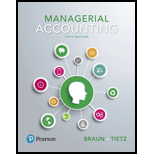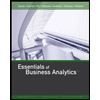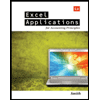
Identify product costs, period costs, and product costing system (Learning Objective 1) Smarties, the sugar candy that is packaged in rolls of 15 small candies, come in six flavors: white (orange crème), yellow (pineapple), pink (cherry), green (strawberry), purple (grape), and orange (orange). Smarties are gluten free and vegan and have 25 calories per roll of 15 candies. The main ingredient in Smarties is dextrose, a form of sugar.
The Smarties Candy Company, founded in 1949, makes its Smarties candy in a New Jersey plant. Its founder bought gunpowder pellet machines after World War I and repurposed them to make the tablet-shaped candies. Smarties are made by color in large batches and then dumped together to be sorted by machines into rolls and packs. Three granddaughters of the original founder of Smarties now run the company and have been working to improve efficiency. Their chief mechanic designed a faster candy press and a new wrapper machine. Previously, 125 Smarties rolls could be wrapped per minute; now 200 rolls can be wrapped per minute. Smarties are produced 24 hours a day in continuous batches.
The Smarties Candy Company has its one main product that is likely to account for most of its sales, but recently it introduced Smarties ‘n creme, which are tablets that are about the size of a quarter and have a flavor burst that is half fruit (strawberry, blueberry, raspberry, peach, or orange) and half cream (dairy-free).
Requirements
- 1. Give an example of each of the following types of costs at the Smarties Candy Company:
- a. Direct material
- b. Direct labor
- c. Manufacturing
overhead - d. Selling and administrative expense
- 2. Assume that only Smarties candies are made in the New Jersey plant. Do you think the Smarties Candy Company is likely to use
job order costing orprocess costing ? Explain. - 3. If the New Jersey plant begins to produce Smarties ‘n creme in addition to Smarties candy rolls, would this change be likely to impact whether the company uses job order costing or process costing? Why or why not?
Trending nowThis is a popular solution!

Chapter 3 Solutions
Managerial Accounting (5th Edition)
- Joe and Ethan each own 50% of JH Corporation, a calendar year taxpayer. Distributions from JH are: $750,000 to Joe on April 1 and $250,000 to Ethan on May 1. JH’s current E & P is $300,000 and its accumulated E & P is $600,000. How much of the accumulated E & P is allocated to Ethan’s distribution? a. $0b. $75,000c. $150,000d. $300,000e. None of the above b or c?arrow_forwardPlease provide the accurate answer to this general accounting problem using appropriate methods.arrow_forwardI need guidance with this general accounting problem using the right accounting principles.arrow_forward
- Please provide the accurate answer to this general accounting problem using appropriate methods.arrow_forwardPlease provide the correct answer to this general accounting problem using accurate calculations.arrow_forwardI am looking for the correct answer to this general accounting problem using valid accounting standards.arrow_forward
- SUBJECT = GENERAL ACCOUNTINGarrow_forwardI am looking for the correct answer to this general accounting question with appropriate explanations.arrow_forwardJH Corporation is a calendar year taxpayer formed in 2014 JH’s E & P before distributions for each of the past 5 years is listed below. 2018 $28,000 2017 $40,000 2016 $39,000 2015 $68,000 2014 $16,000 JH Corporation made the following distributions in the previous 5 years. 2017 Land (basis of $70,000, fair market value of $80,000) 2014 $20,000 cash JH’s accumulated E & P as of January 1, 2019 is: a. $91,000.b. $95,000.c. $101,000. d. $105,000.e. None of the above.arrow_forward
 Essentials of Business Analytics (MindTap Course ...StatisticsISBN:9781305627734Author:Jeffrey D. Camm, James J. Cochran, Michael J. Fry, Jeffrey W. Ohlmann, David R. AndersonPublisher:Cengage LearningPrinciples of Accounting Volume 2AccountingISBN:9781947172609Author:OpenStaxPublisher:OpenStax College
Essentials of Business Analytics (MindTap Course ...StatisticsISBN:9781305627734Author:Jeffrey D. Camm, James J. Cochran, Michael J. Fry, Jeffrey W. Ohlmann, David R. AndersonPublisher:Cengage LearningPrinciples of Accounting Volume 2AccountingISBN:9781947172609Author:OpenStaxPublisher:OpenStax College Excel Applications for Accounting PrinciplesAccountingISBN:9781111581565Author:Gaylord N. SmithPublisher:Cengage Learning
Excel Applications for Accounting PrinciplesAccountingISBN:9781111581565Author:Gaylord N. SmithPublisher:Cengage Learning Cornerstones of Cost Management (Cornerstones Ser...AccountingISBN:9781305970663Author:Don R. Hansen, Maryanne M. MowenPublisher:Cengage Learning
Cornerstones of Cost Management (Cornerstones Ser...AccountingISBN:9781305970663Author:Don R. Hansen, Maryanne M. MowenPublisher:Cengage Learning College Accounting, Chapters 1-27AccountingISBN:9781337794756Author:HEINTZ, James A.Publisher:Cengage Learning,
College Accounting, Chapters 1-27AccountingISBN:9781337794756Author:HEINTZ, James A.Publisher:Cengage Learning,




